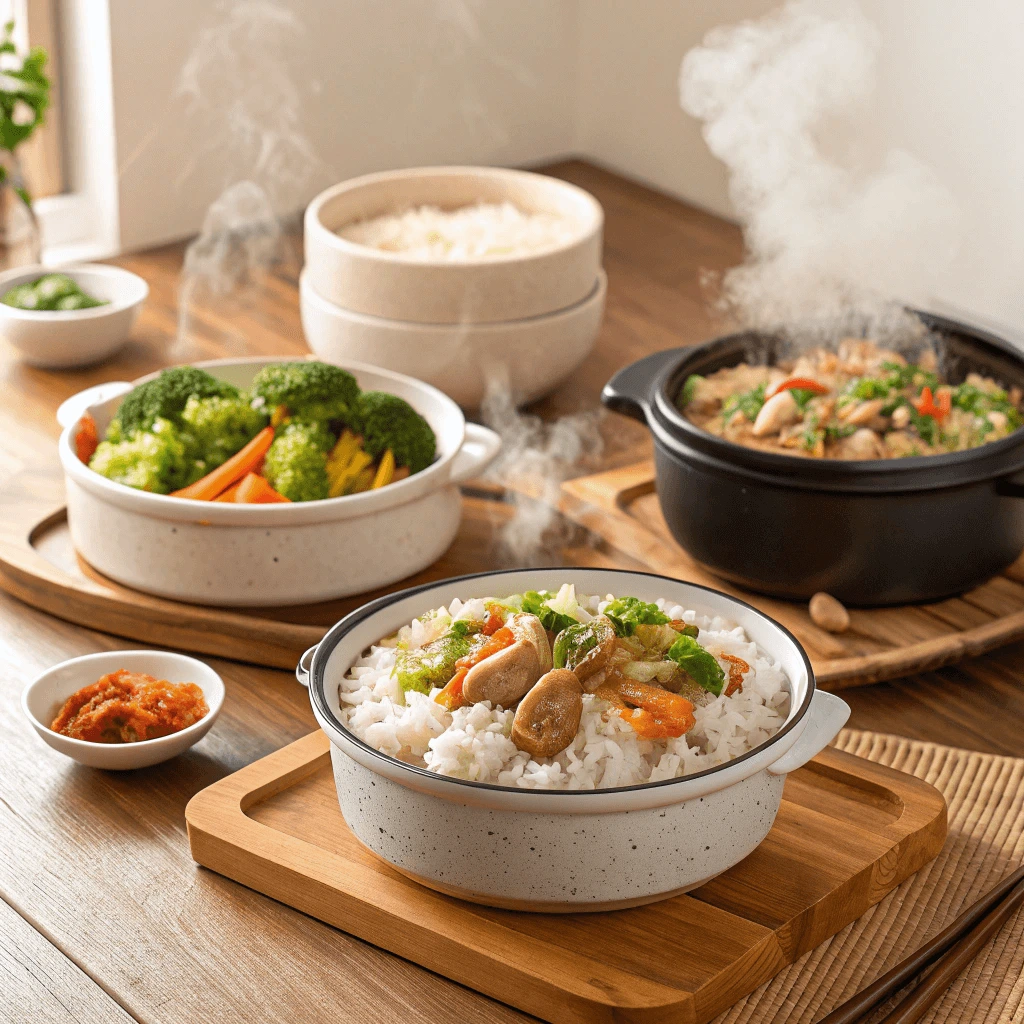Rice is a staple in many households, offering versatility and value like no other ingredient. Whether you have leftover rice or need a budget-friendly meal,rice hack recipes are a game-changer. These recipes transform simple rice into mouthwatering dishes that are easy on the wallet and perfect for feeding a crowd. In this blog post, we’ll explore how rice hack recipes can save you time and money while still delivering meals that everyone in the family will love. Get ready to discover simple and delicious ways to make the most out of rice!
Quick and Easy Rice Hack Recipes for Busy Days
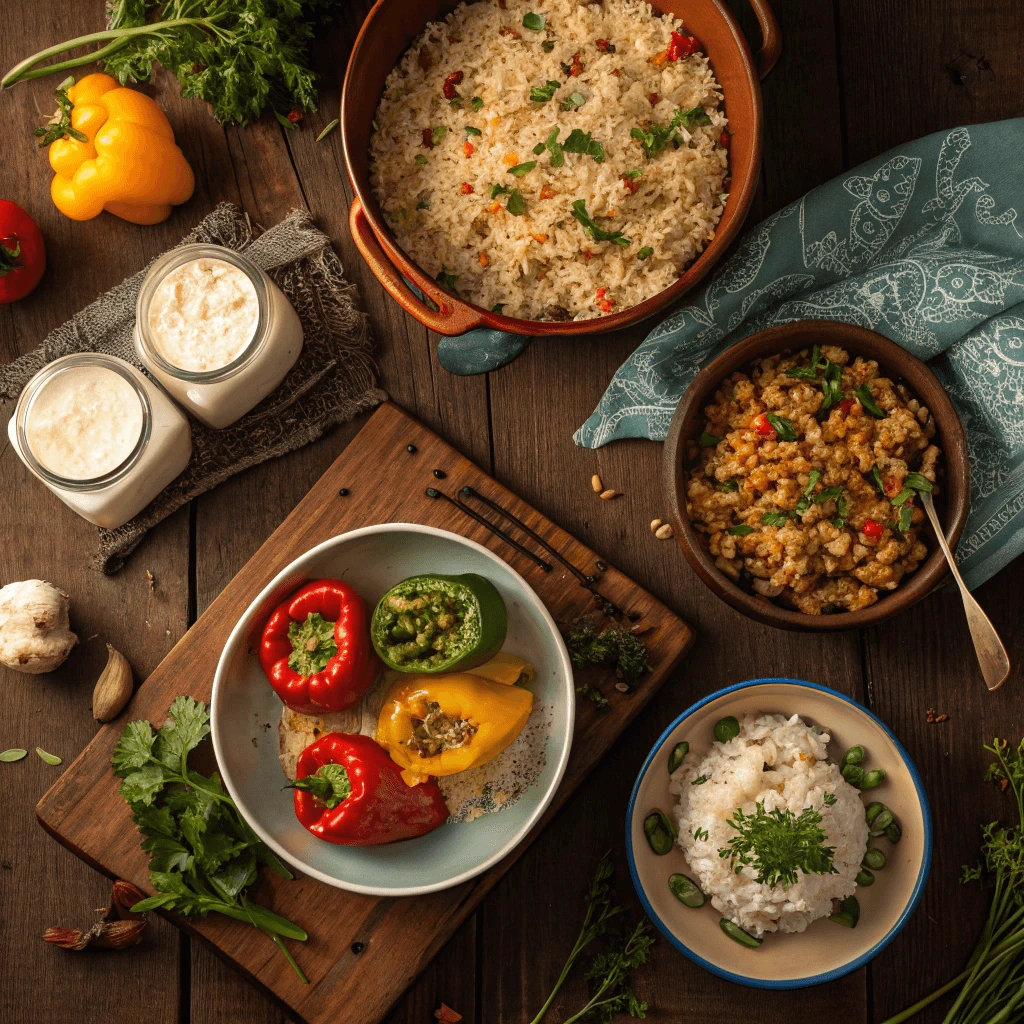
5-Minute Garlic Fried Rice Hack
This quick and flavorful garlic fried rice is a perfect rice hack for transforming leftover rice into a satisfying meal. Using day-old rice helps the grains stay separate and crisp up nicely, giving you a delicious texture. It’s budget-friendly, ready in minutes, and made with ingredients you probably already have at home.
Ingredients You’ll Need
- 2 cups cold, leftover jasmine or white rice
- 3 cloves garlic, minced
- 1 tablespoon soy sauce (or tamari for gluten-free)
- 1 tablespoon neutral oil (canola, sunflower, or vegetable oil)
- ½ cup frozen mixed vegetables (optional)
- Salt and pepper to taste
- Optional toppings: green onions, sesame seeds, fried egg
Step-by-Step Instructions
Heat oil in a nonstick skillet or wok over medium-high heat. Once the oil is hot, add the minced garlic and stir-fry for about 30 seconds until it becomes fragrant and lightly golden.
If you’re using frozen vegetables, add them next and cook for 1 to 2 minutes until they heat through. Break up the cold rice with your hands or a spoon, then add it to the pan. Stir-fry the rice for 2 to 3 minutes, allowing some of the grains to crisp up for extra flavor.
Drizzle in the soy sauce and toss everything to coat the rice evenly. Season with salt and pepper to taste. You can also top your rice with a fried egg, tofu, or chopped herbs for added texture and nutrition.
Why This Hack Works
This rice hack works because it’s fast, flexible, and uses leftovers creatively. Cold rice doesn’t clump, so it fries better. You only need one pan, so cleanup is minimal. Plus, you can customize it with whatever vegetables or proteins you have on hand. It’
Microwave Mug Rice Omelet Hack
A microwave mug rice omelet is one of the easiest and most convenient rice hacks you can make. It’s a perfect solution for busy mornings, quick lunches, or even late-night snacks. Using leftover rice, eggs, and simple mix-ins, this dish comes together in just minutes—no stove required.
Ingredients You’ll Need
- ½ cup cooked rice (white, brown, or jasmine)
- 2 eggs
- 2 tablespoons milk or plant-based alternative
- 2 tablespoons shredded cheese (optional)
- A handful of chopped vegetables (like bell peppers, spinach, or onions)
- Salt and pepper to taste
- Optional: chopped cooked chicken, turkey, or tofu for added protein
Quick Preparation Steps
Start by choosing a microwave-safe mug that’s at least 12 ounces in size. Lightly grease the inside with oil or cooking spray to prevent sticking. In the mug, whisk together the eggs and milk until fully combined.
Next, stir in the cooked rice, vegetables, cheese, and any protein you’re using. Season the mixture with salt and pepper. Make sure everything is well mixed so the ingredients cook evenly.
Microwave the mug on high for 1 minute. Stir the contents gently, then continue microwaving in 30-second intervals until the eggs are fully set—usually about 2 to 3 minutes total, depending on your microwave’s power. Let it cool for a minute before enjoying.
Why It Works as a Rice Hack
This rice hack is brilliant because it uses minimal ingredients, zero pans, and practically no cleanup. The microwave method saves time, and the flexibility of ingredients means you can adapt the recipe to whatever leftovers you have. It’s portion-controlled, budget-friendly, and surprisingly filling.
Pro Tips for Success
Use day-old rice to keep the texture light. Fresh rice can get soggy in the microwave. Cut vegetables into small pieces so they cook quickly. If you’re in a rush, pre-mix ingredients the night before and just pop it in the microwave when you’re ready to eat.
Spicy Kimchi Fried Rice Hack
Spicy kimchi fried rice is a bold, flavorful way to upgrade leftover rice. It’s quick, customizable, and perfect for busy weeknights when you want something satisfying with a kick.
Quick Ingredients
- 1 cup cold, cooked rice
- ½ cup chopped kimchi
- 1 tablespoon kimchi juice
- 1 tablespoon gochujang (Korean chili paste)
- 1 garlic clove, minced
- 1 green onion, chopped
- 1 tablespoon soy sauce
- 1 teaspoon sesame oil
- Optional: fried egg, sesame seeds, avocado
Simple Cooking Steps
Heat sesame oil in a pan over medium-high heat. Sauté the garlic and green onion until fragrant. Add the chopped kimchi and cook it for a few minutes until slightly caramelized. Stir in the rice, breaking up any clumps, then add soy sauce, kimchi juice, and gochujang. Mix well and stir-fry for a few minutes until the rice is hot and evenly coated. Top with a fried egg if you like.
Why You’ll Love It
This dish uses leftovers but tastes gourmet. The spicy, tangy kimchi pairs perfectly with the richness of the egg and umami from the gochujang. It’s affordable, satisfying, and packed with flavor.
Budget-Friendly One-Pot Rice Hack Recipes
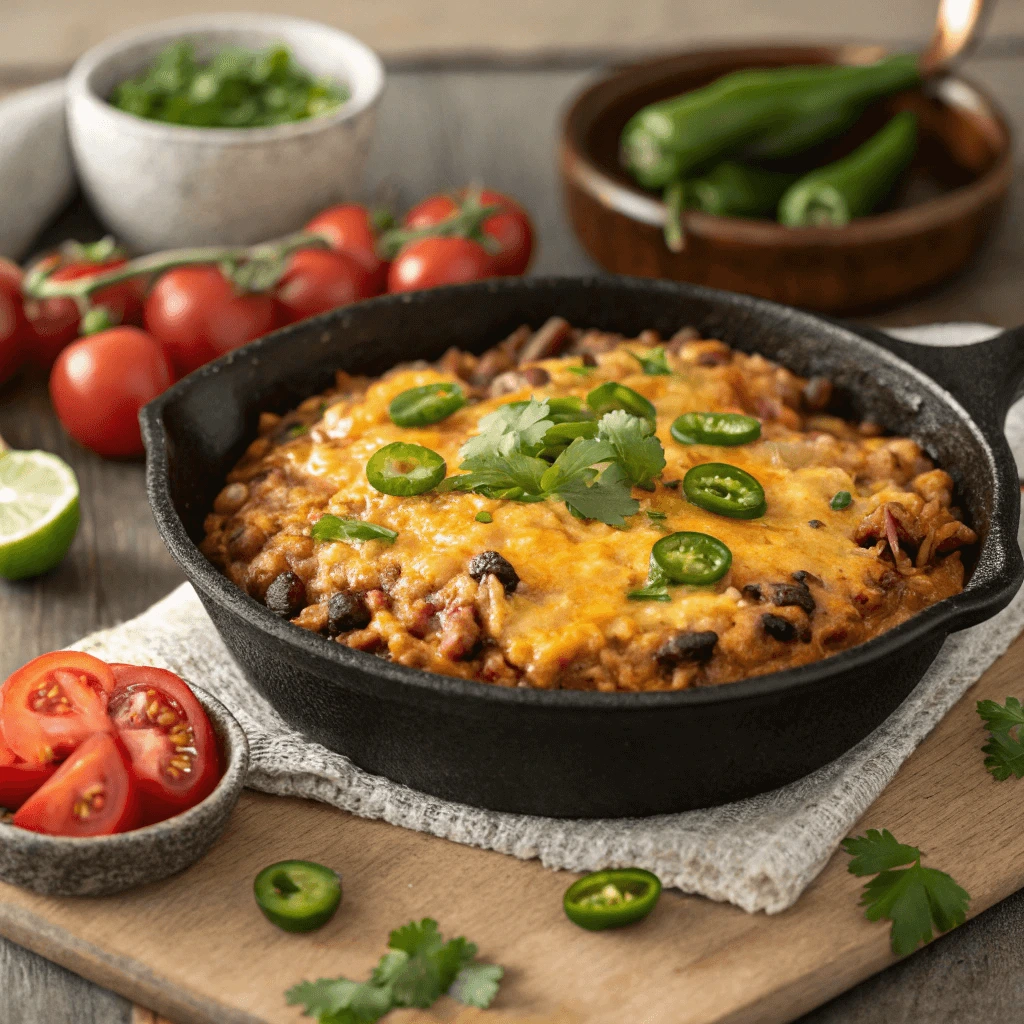
Cheesy Rice and Bean Skillet Hack
The cheesy rice and bean skillet is an easy, one-pan meal that’s both comforting and filling. It combines leftover rice, beans, and melted cheese into a delicious, budget-friendly dish.
Ingredients Needed
- 1 cup cooked rice
- 1 can black beans, drained and rinsed
- 1 cup shredded cheddar cheese
- 1 tablespoon olive oil
- ½ onion, chopped
- 1 garlic clove, minced
- 1 teaspoon cumin
- ½ teaspoon chili powder
- Salt and pepper to taste
Quick Steps to Make It
- Sauté Aromatics: Heat olive oil in a skillet, add chopped onion and garlic, and sauté until fragrant.
- Combine Rice and Beans: Stir in rice and black beans, then season with cumin, chili powder, salt, and pepper.
- Melt the Cheese: Top with cheese, cover the skillet, and cook until melted.
- Garnish and Serve: Garnish with cilantro (optional) and serve!
Why It Works
This dish is quick to prepare, and the combination of rice and beans provides a nutritious, satisfying meal. It’s easy to customize with your favorite add-ins like veggies or extra spice.
Simple Jambalaya Rice Hack Recipe
This simple jambalaya rice hack is the perfect solution when you want to enjoy a hearty, flavorful meal without spending hours in the kitchen. It transforms basic ingredients into a savory dish filled with bold spices and delicious textures, making it a great way to use up leftover rice.
Key Ingredients for Jambalaya Rice Hack
- 2 cups cooked rice (preferably leftover rice for the best texture)
- 1/2 lb sausage (turkey or chicken sausage works well)
- 1 cup shrimp (optional, can be substituted with chicken or more sausage)
- 1 bell pepper, diced
- 1 medium onion, diced
- 2 cloves garlic, minced
- 1 can diced tomatoes (14.5 oz)
- 1/2 teaspoon smoked paprika
- 1/2 teaspoon thyme
- 1/2 teaspoon cayenne pepper (optional for heat)
- Salt and pepper to taste
- 1 tablespoon olive oil
- Fresh parsley for garnish
Step-by-Step Instructions
- Cook the Sausage and Shrimp: Start by heating olive oil in a large skillet over medium heat. Slice the sausage and cook until it’s browned. Add the shrimp and cook for another 2-3 minutes until they turn pink. Remove both the sausage and shrimp from the skillet and set aside.
- Sauté the Vegetables: In the same skillet, add a bit more oil if necessary. Toss in the diced onion, bell pepper, and garlic, and sauté until they soften, about 3-4 minutes.
- Add Tomatoes and Spices: Stir in the diced tomatoes, smoked paprika, thyme, cayenne pepper, and a pinch of salt and pepper. Let the mixture simmer for about 5 minutes, allowing the flavors to meld together.
- Combine with Rice: Add the cooked rice to the skillet and mix well, breaking up any clumps. Return the cooked sausage and shrimp to the skillet, and stir everything together. Let it cook for an additional 3-4 minutes until everything is heated through.
- Garnish and Serve: Garnish the jambalaya rice with fresh parsley and serve. Enjoy!
Why This Hack Works
This jambalaya rice hack works because it simplifies the traditional jambalaya recipe by using leftover rice and fewer ingredients. The combination of sausage, shrimp, and vegetables brings that classic jambalaya flavor without the need for long cooking times or complex steps. It’s also highly customizable, allowing you to use whatever protein or vegetables you have on hand.
Curried Veggie Rice Hack
The Curried Veggie Rice Pot is an easy, one-pot dish that brings together the flavors of vegetables and curry in a delicious, satisfying meal. It’s simple to make with ingredients you probably already have at home and is perfect for transforming leftover rice into a flavorful dinner. Packed with vegetables, spices, and a creamy coconut milk base, this dish is both comforting and healthy.
Ingredients:
- 2 cups cooked rice
- 1 cup carrots, chopped
- 1 cup peas
- 1 onion, chopped
- 1 bell pepper, chopped
- 1 zucchini, chopped
- 2 tbsp curry powder
- 1 can coconut milk
- 1 cup vegetable broth
- Olive oil for cooking
- Salt and pepper to taste
- Fresh cilantro for garnish
Instructions:
- Cook the veggies: Heat olive oil in a large pot and sauté the onion, carrots, bell pepper, and zucchini until they are soft.
- Spice it up: Add curry powder, cumin, and turmeric. Stir the spices into the vegetables for a couple of minutes to bring out their flavors.
- Add liquids and rice: Pour in the coconut milk and vegetable broth, letting it simmer for 5 minutes. Then, stir in the cooked rice, allowing it to soak up all the flavors.
- Season and serve: Adjust seasoning with salt and pepper and garnish with cilantro.
This recipe is versatile—swap in your favorite veggies, and it’s a perfect meal for any time of the week. The coconut milk gives it a rich and creamy texture, while the curry spices add depth to the dish. It’s ideal for both vegetarians and meat-eaters alike!
Creative Rice Hack Recipes to Repurpose Leftovers
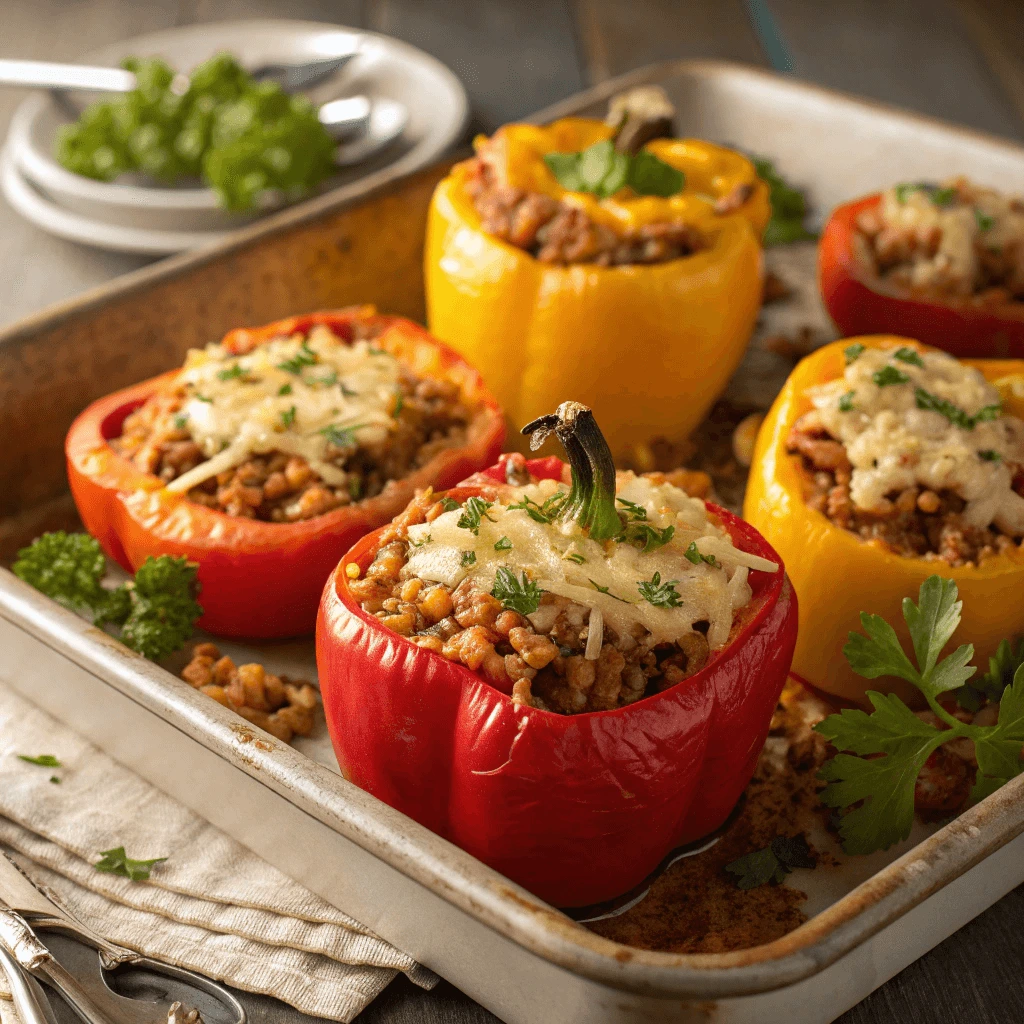
Rice-Stuffed Bell Peppers
Rice-Stuffed Bell Peppers are a fantastic way to turn leftover rice into a flavorful and satisfying meal. With their vibrant color and hearty filling, these stuffed peppers are a true crowd-pleaser. Whether you’re using ground meat, beans, or a mix of both, the result is a balanced dish that’s both nutritious and delicious.
Key Ingredients:
- Bell peppers (choose your favorite color)
- Cooked rice
- Ground meat or beans (optional)
- Tomatoes, onions, cheese, and herbs
Simple Preparation:
- Prepare the peppers: Cut the tops off the bell peppers and remove the seeds. If needed, trim the bottoms to ensure they stand upright.
- Mix the filling: Combine your cooked rice with your choice of protein (ground meat, beans, or tofu) and sautéed vegetables like onions and tomatoes. Season with herbs, spices, and a bit of cheese for extra flavor.
- Stuff and bake: Carefully stuff the peppers with the rice mixture and top with a sprinkle of cheese. Bake at 375°F for 20-30 minutes, or until the peppers are tender and the cheese is golden brown.
Rice-Stuffed Bell Peppers are highly versatile. You can make them ahead for meal prep or serve them as a side dish. Feel free to swap in different proteins or veggies to suit your taste preferences. This recipe is not only budget-friendly but also a great way to reduce food waste by using up leftover rice.
Creamy “Cheater’s” Mushroom Risotto
Making risotto doesn’t have to be complicated. This Cheater’s Mushroom Risotto is a simpler, quicker version that delivers all the creamy, comforting flavors without the constant stirring. It’s perfect for those days when you want a hearty meal but don’t have time to stand over the stove.
Key Ingredients:
- Arborio rice or short-grain rice
- Fresh mushrooms (button or cremini)
- Onion and garlic
- Vegetable or chicken broth
- Heavy cream or milk
- Parmesan cheese
How to Make It:
1. Sauté the Veggies
Start by cooking onions, garlic, and mushrooms in a pan with some butter and olive oil. This forms the flavor base.
2. Add the Rice
Stir in the rice to coat it with the butter mixture. Let it toast lightly for a couple of minutes.
3. Gradually Add Broth
Slowly add the broth in small amounts, letting the rice absorb it between each addition.
4. Stir in Cream and Cheese
Once the rice is cooked, mix in the cream and Parmesan cheese for a rich and creamy texture.
This Cheater’s Mushroom Risotto provides the same comforting flavors as traditional risotto but with less effort and time. Perfect for a quick weeknight meal or when you’re craving something rich but easy to prepare.
Rice Pancakes or Patties
Rice pancakes or patties are an excellent way to use up leftover rice while creating a delicious, versatile dish. This simple recipe is a fun way to transform your leftover rice into crispy, savory treats. Whether you serve them for breakfast, as a snack, or as a side dish, rice pancakes or patties are sure to become a family favorite.
Key Ingredients:
- Leftover rice (white, brown, or jasmine works best)
- Eggs to bind the mixture
- Flour (all-purpose or rice flour for a gluten-free option)
- Green onions or herbs for added flavor
- Grated cheese (optional for extra richness)
- Salt and pepper for seasoning
- Olive oil or butter for frying
How to Make Rice Pancakes or Patties:
1. Mix the Ingredients
In a large bowl, combine the leftover rice, beaten eggs, flour, finely chopped green onions, and any additional flavorings you prefer. Season the mixture with salt and pepper to taste. If you want a richer flavor, add some grated cheese.
2. Shape the Patties
Use your hands or a spoon to form the rice mixture into small patties. If the mixture feels too wet, add a little more flour to help bind it together.
3. Fry the Patties
Heat a pan over medium heat and add a little oil or butter. Once hot, add the patties and cook for about 3-4 minutes on each side or until they turn golden and crispy.
4. Serve and Enjoy
Rice pancakes or patties can be served hot with a dipping sauce like soy sauce, garlic sauce, or a yogurt-based dip. They are perfect for a light lunch, a quick snack, or as a side dish for dinner.
Variations to Try:
- Vegetable Rice Patties: Add shredded carrots, zucchini, or peas to the mixture for extra nutrition.
- Spicy Rice Patties: Mix in some chili flakes or hot sauce for a bit of heat.
- Cheesy Rice Patties: For a more indulgent version, add melted cheese in the center of each patty before frying.
Rice pancakes or patties are highly customizable, so feel free to get creative with your ingredients. They’re a perfect way to breathe new life into leftover rice and are a great addition to your repertoire of easy, budget-friendly meals.
Sweet Rice Hack Recipes for Dessert
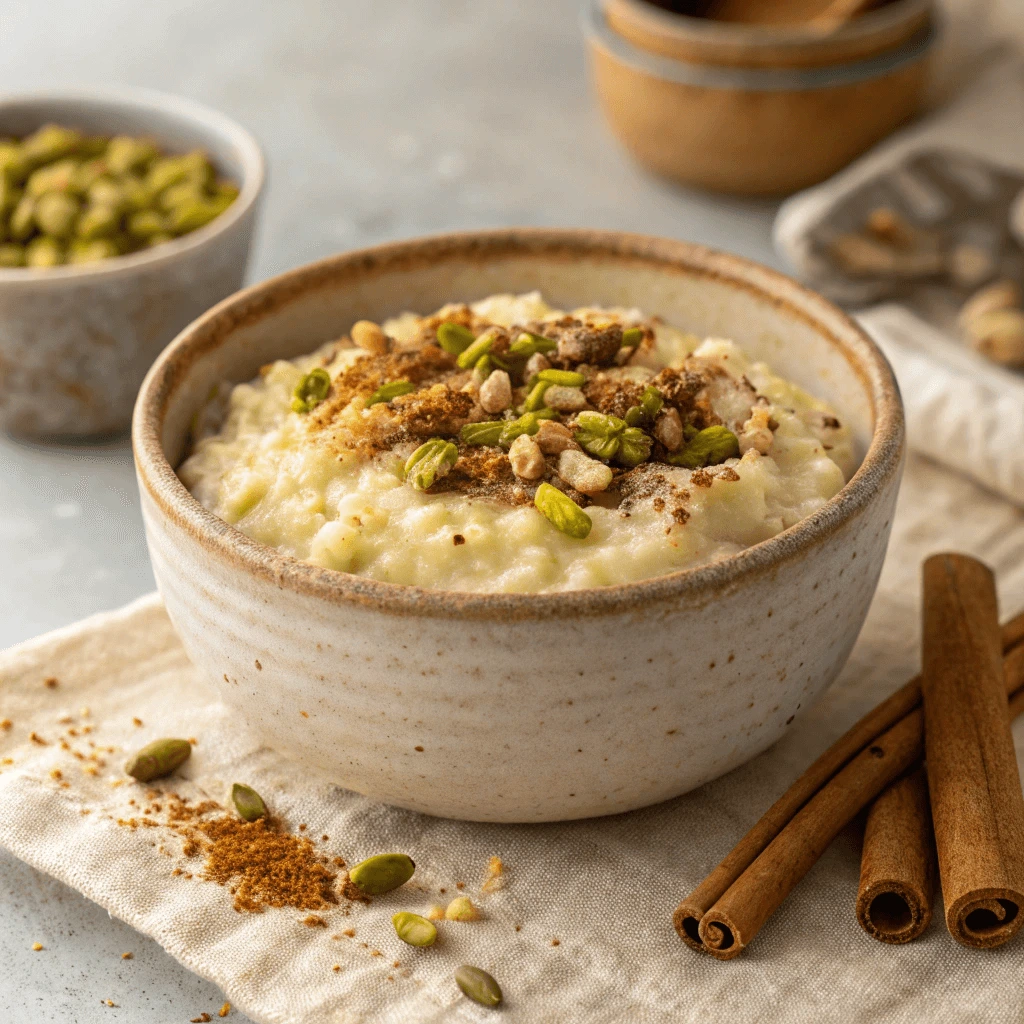
Classic Cardamom Rice Pudding
Classic cardamom rice pudding is a simple, comforting dessert that turns leftover rice into a creamy, fragrant treat. The warming cardamom flavor combined with the smooth rice and milk makes for a perfect indulgence. It’s a versatile dessert enjoyed in many cultures, and it’s easy to make with just a few ingredients.
Ingredients:
- Leftover rice (best if it’s a day old)
- Whole milk (or a dairy-free option like almond or coconut milk)
- Sugar (white or brown sugar)
- Ground cardamom
- Vanilla extract (optional)
- Chopped nuts (pistachios, almonds) for garnish
- Raisins (optional)
How to Make Cardamom Rice Pudding:
- Heat the Milk: Combine milk, sugar, and a pinch of salt in a saucepan. Heat until the sugar dissolves and the milk is warm, but don’t let it boil.
- Add Rice and Cardamom: Stir in the leftover rice and ground cardamom. Let it simmer for about 15-20 minutes, stirring occasionally.
- Flavor It: Once the mixture thickens, add vanilla extract for extra flavor.
- Serve: Spoon the pudding into bowls and garnish with chopped nuts or raisins.
Variations:
- Coconut Cardamom Rice Pudding: Use coconut milk for a tropical twist.
- Saffron Rice Pudding: Add saffron strands for a golden, aromatic touch.
- Cinnamon Rice Pudding: Stir in cinnamon for a warm, spicy flavor.
This easy-to-make rice pudding is perfect for using up leftover rice and makes a delicious, aromatic dessert.
Chocolate Coconut Rice Balls
Chocolate coconut rice balls are a quick and delicious treat made from leftover rice. The combination of chocolate and coconut gives these bite-sized snacks a rich, tropical flavor. Perfect for satisfying a sweet craving, they are easy to prepare and require no baking.
Ingredients:
- 2 cups leftover cooked rice
- ½ cup unsweetened shredded coconut
- ¼ cup cocoa powder
- ¼ cup maple syrup or honey
- 1 tsp vanilla extract
- Pinch of salt
- ¼ cup mini chocolate chips (optional)
Instructions:
- Mix Ingredients: In a bowl, combine the rice, cocoa powder, shredded coconut, maple syrup, vanilla, and salt.
- Form Balls: Roll the mixture into small balls using your hands.
- Add Chocolate Chips: If desired, fold in mini chocolate chips for extra flavor.
- Chill and Serve: Place the rice balls in the fridge for about 30 minutes before serving.
These rice balls are not only tasty but also customizable to suit your taste. Add nuts, dried fruit, or more chocolate for variety. A perfect treat for any occasion!
Cinnamon Apple Rice Bake
Cinnamon Apple Rice Bake is a delightful dessert that transforms leftover rice into a warm and comforting dish. The sweetness of apples, paired with the spiciness of cinnamon, creates a perfect balance, while the rice adds a hearty texture. It’s an easy-to-make, crowd-pleasing treat that everyone will enjoy.
Ingredients:
- 2 cups cooked rice (preferably day-old rice)
- 2 large apples, peeled and diced
- 1 cup milk (dairy or plant-based)
- ½ cup brown sugar
- 1 tsp ground cinnamon
- 1 tsp vanilla extract
- 2 tbsp butter, melted
- Pinch of salt
- Optional: 1 egg for creaminess, chopped nuts, raisins, or dried cranberries
Instructions:
- Preheat the oven to 350°F (175°C) and grease a baking dish.
- Mix cooked rice, milk, brown sugar, cinnamon, vanilla, and melted butter in a bowl.
- Add diced apples (and raisins or dried cranberries, if using).
- For extra creaminess, whisk in an egg (optional).
- Pour the mixture into the baking dish and top with chopped nuts (optional).
- Bake for 35-40 minutes, or until the top is golden and apples are tender.
Tips:
- For added crunch, sprinkle chopped nuts on top before baking.
- Make it vegan by using plant-based milk and skipping the egg.
- Spice it up with a pinch of nutmeg or allspice for a deeper flavor.
This Cinnamon Apple Rice Bake is a simple and creative way to use up leftover rice while indulging in a comforting, flavorful dessert.
Pro Tips for Successful Rice Meal Prep and Storage
Best Ways to Store Cooked Rice Hack
Properly storing cooked rice ensures it stays fresh, safe, and delicious. If stored incorrectly, rice can lose its texture and even pose health risks. Here are the best ways to store your cooked rice.
Short-Term Storage: Refrigeration
For rice you’ll use in a few days, refrigerating is the best option.
- Cool Rice Quickly: Spread it out on a plate or tray to cool it to room temperature. Avoid letting it sit out for too long to prevent bacteria growth.
- Use an Airtight Container: Transfer cooled rice to an airtight container. Seal it tightly to maintain freshness and prevent moisture loss. It can stay in the fridge for about 3-4 days.
- Reheat Safely: When reheating, make sure to bring the rice to at least 165°F (74°C) to kill any bacteria.
Long-Term Storage: Freezing
If you want to store rice for longer, freezing is the best method.
- Cool It Completely: Let the rice cool before freezing to avoid ice crystals and freezer burn.
- Use Freezer-Safe Bags or Containers: Divide rice into portions and store in freezer-safe bags or containers. Squeeze out air from bags to prevent freezer burn.
- Label and Date: Label each package with the date it was stored. Rice can be frozen for 1-2 months without losing quality.
- Reheat from Frozen: You can reheat rice directly from the freezer. Use the microwave or stovetop with a little water until it’s hot.
Extra Tips for Storing Rice
- Don’t store rice in the cooking pot. Transfer it to another container to avoid moisture buildup.
- Use rice within a reasonable time. Even frozen rice loses quality over time, so try to consume it within a couple of months.
By following these storage tips, you can keep your rice fresh for days or weeks without compromising on flavor.
Mason Jar Rice Salads
Mason jar rice salads are an excellent option for meal prep, offering both convenience and flavor. They are simple to make and keep your ingredients fresh for days. Let’s explore how you can create these easy, portable salads.
Why Use Mason Jars?
Mason jars offer great portability, perfect for lunch on the go or a quick dinner. They also help preserve freshness by keeping the ingredients sealed until you’re ready to eat. The layers inside the jar keep everything organized and prevent sogginess.
Key Ingredients for Rice Salads
Creating a mason jar rice salad is all about layering. Start with cooked rice as your base, then add protein like chicken or chickpeas, followed by vegetables and greens. A good dressing at the bottom will keep everything fresh until you’re ready to mix and enjoy.
Assembling Your Salad
To build your salad, start by adding the dressing to the bottom of the jar. Then, layer in rice, protein, and veggies. Finish off with toppings like nuts or cheese for extra crunch and flavor. Seal the jar and refrigerate for up to 3 days for a fresh, easy meal.
Mason jar rice salads are versatile and can be customized to fit any dietary preference, making them a perfect option for busy days.
Freezer-Ready Stir-Fry Packs
Freezer-ready stir-fry packs are a great way to save time during busy weeks while ensuring you always have a healthy, homemade meal on hand. With all the ingredients prepped and stored, these packs make cooking stir-fry quick and easy—perfect for when you’re short on time.
Why Make Freezer-Ready Stir-Fry Packs?
Making these packs in advance is an excellent time-saver. You can prepare several servings at once, and then have a delicious meal ready in minutes. Whether you’re prepping for a hectic week or just want to avoid the hassle of chopping veggies every day, these packs give you the convenience of a homemade meal without the effort.
What Goes Into a Stir-Fry Pack?
To create a stir-fry pack, choose a protein like chicken, tofu, or shrimp, along with your favorite veggies, such as bell peppers, onions, or broccoli. Pre-chopped frozen veggies are great, but you can also use fresh ingredients if preferred. For added flavor, include a small amount of garlic, ginger, or other seasoning. Separate the stir-fry sauce into a small bag or jar to keep it from soaking into the veggies.
How to Cook Stir-Fry from a Freezer Pack
Cooking the pack is simple. Heat some oil in a pan over medium-high heat, and add the frozen ingredients directly from the freezer. Stir-fry for about 5-7 minutes, adding the sauce toward the end. You’ll have a quick, flavorful dish that’s ready in no time!
Freezer-ready stir-fry packs help you stay organized and save valuable time in the kitchen while still enjoying a nutritious meal. With a little upfront work, you’ll have healthy meals ready to go anytime you need them!
Conclusion
Rice hack recipes offer endless versatility and affordability, transforming simple ingredients into delicious and creative meals. Whether you’re reinventing leftovers or trying new combinations, these hacks can simplify meal prep while minimizing food waste. By experimenting with different flavors and techniques, you’ll discover countless ways to make rice exciting and enjoyable. Don’t be afraid to get creative with your rice dishes! Tried one of these rice hacks or have your own favorite rice tip? Share it in the comments below!
